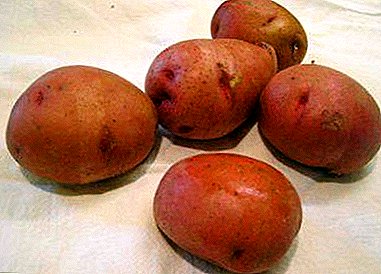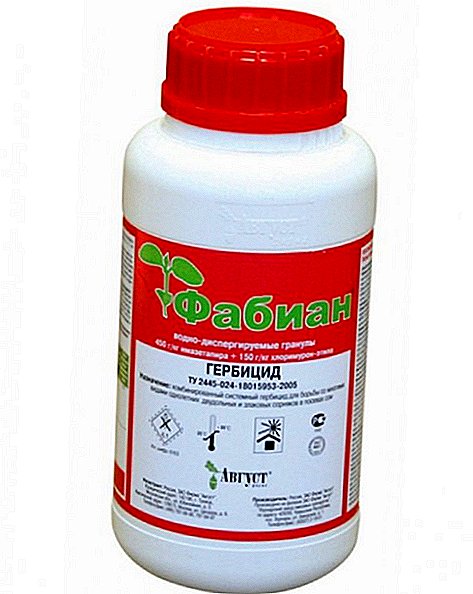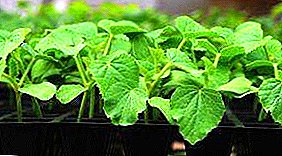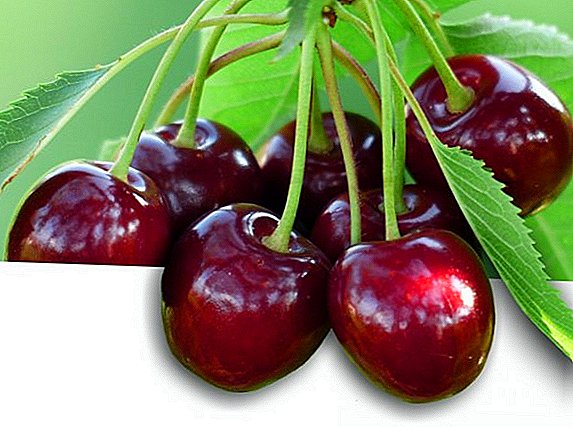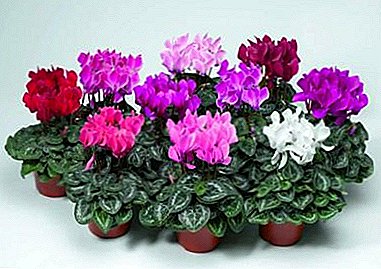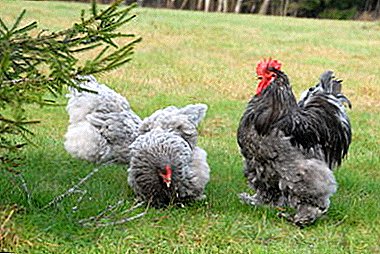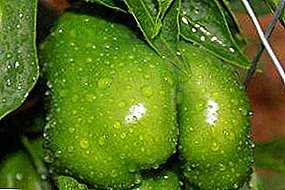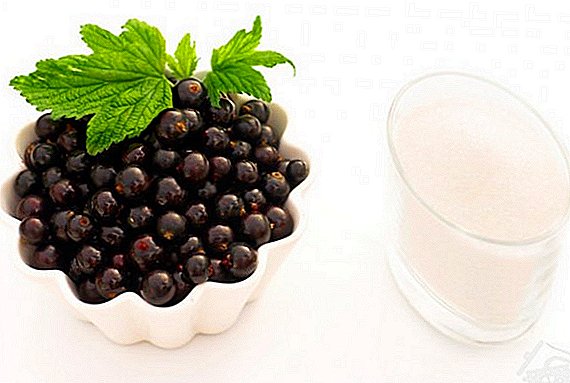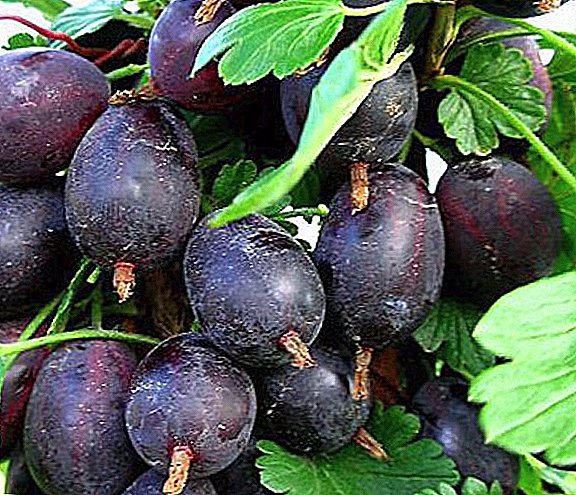 Gooseberry is one of the favorite plants of many gardeners. The popularity of such a bush is due to its unpretentiousness to weather conditions, the sweet taste and fleshyness of the fruit, the minimum cost to care. In this article we will look at this type of gooseberry, which is called "Grushenka": description of the variety, cultivation agrotechnology and peculiarities of care.
Gooseberry is one of the favorite plants of many gardeners. The popularity of such a bush is due to its unpretentiousness to weather conditions, the sweet taste and fleshyness of the fruit, the minimum cost to care. In this article we will look at this type of gooseberry, which is called "Grushenka": description of the variety, cultivation agrotechnology and peculiarities of care.
Characteristics and individual features of the variety
The peculiarity of this variety is its relatively young age of existence - "Grushenka" was bred by breeders at the Research Institute in the 80s of the last century. A prerequisite for the emergence of such a variety was the desire of scientists to bring out a variety that would be frost-resistant, had a large sweet fruit, and also did not have thorns that are so characteristic of gooseberries.  After several years of hard work (during which the Kolobok and Eaglet varieties were created with underdeveloped spike shoots), Grushenka was bred by hybridizing about 12 elite varieties.
After several years of hard work (during which the Kolobok and Eaglet varieties were created with underdeveloped spike shoots), Grushenka was bred by hybridizing about 12 elite varieties.
Did you know? This variety got its name due to the fact that the fruits of gooseberry in shape resemble a rounded pear.
This variety has such features and characteristics:
- ripening period - medium late (it ripens at the end of July - the first half of August). Immediately the fruits are formed early, at first they have a pinkish color, and by the time of ripeness they reach a deep purple color;
- frost resistance - absolute. This variety is remarkable in that it is resistant to frost - it is able to withstand any climatic and weather conditions up to extreme heat (except for strong hail). In addition, the bush is able to transfer powdery mildew and various viral diseases;
- bush - medium height, spreading weak. It is characterized by a dense density of leaves, the absence of thorns on the branches and their drooping towards the ground. New shoots have a good branching of medium thickness;
- bloom - two-color and tricolor inflorescences. Belongs to early flowering plants;
- fruit - berries are large (average weight of one fruit - 4.5 g), deep purple-burgundy tone. Taste is sweet-sour, well-marked, fruits are juicy and fleshy. It is noteworthy that the composition of such berries include pectin and anthocyanin substances. Fruits long enough period - up to 20 years;
- yield - average. One bush produces about 7 kg of berries.

Advantages and disadvantages
Professional breeders and amateur gardeners highlight the following positive aspects of this variety:
- frost resistance and immunity to high temperatures;
- relative plant simplicity;
- significant yields and fruiting gooseberries;
- good transportability of saplings;
- resistance to major diseases;
- harvesting comfort due to the lack of thorns;
- dense rind of berries, which does not crack or crumple during transportation.
Disadvantages of this variety of gooseberry virtually no. Some gardeners refer to negative factors:
- excessively thick berry density on the twigs. Due to the fact that the fruits are located tightly and each has a considerable weight, the branches bow low to the ground, and when the bush becomes wet, the branches can break off;
- not too high taste of the fruit in its raw form (with a rich harvest, the berries become sour, not sour-sweet);
- the need to quickly pick berries when they ripen (they are quickly moving away).
 From these lists it is clear that the gooseberry "Grushenka" has much more advantages than disadvantages. Now it is time to consider the principles of growing and caring for shrubs.
From these lists it is clear that the gooseberry "Grushenka" has much more advantages than disadvantages. Now it is time to consider the principles of growing and caring for shrubs.What to look for when choosing seedlings
In order for the gooseberry to delight you for many years with its tasty fruits, it is necessary, first of all, to be able to choose good quality seedlings. When choosing seedlings, the first thing you need to pay attention to is the condition of the roots and root collar (a place just above the beginning of the roots). Small roots should be thick and lush, without any damage and especially peeling (this indicates the freezing of the roots).
See also other fruit shrubs: algae algae, goji, grapes, raspberries, currants, sea buckthorn, sunberry and dog rose.
Carefully inspect the root neck - in this place the most often develops the fungus. Also pay attention to how exactly the seller has plant seedlings - the roots should not be located in direct sunlight. Roots of seedlings must either be placed in a box with soil, or at least be covered with a wet cloth.  If you notice that the seedling is in the sun, and the roots are dried - then, most likely, this bush is dead and will no longer grow in the future. If the seedling is already an adult (2 years or more), then it must be transported and sold with a clod of earth on its roots.
If you notice that the seedling is in the sun, and the roots are dried - then, most likely, this bush is dead and will no longer grow in the future. If the seedling is already an adult (2 years or more), then it must be transported and sold with a clod of earth on its roots.
After inspecting the roots, it is worth proceeding to the twigs. Ideal if they are of medium thickness, with good spreading. Remember that a biennial plant should have several skeletal shoots up to 15 cm long, and most importantly, fibrous buds.
Important! It is not necessary to choose gooseberry saplings for planting over 2 years for planting - the best option for engraftment in a new plot is an annual plant.
Planting young seedlings on the site
So, the seedling is selected and successfully transported to your site. Now it is important to carry out the correct planting.
Optimal timing
This bush is suitable for planting in the autumn and spring season. If you plant a plant in spring, you need to do this in a short period between the thawing of the soil and the beginning of the swelling of the gooseberry buds. Therefore, in order not to risk and make a mistake with the time of planting in the spring, it is recommended to plant gooseberries in the autumn - this is guaranteed to ensure a good harvest in the future.  Ideally, planting in the fall should be carried out 4 weeks before the start of frost - at this time the soil is still quite warm, and the roots will take root well in a new place. The best time for this is the beginning of October. Despite the fact that Grushenka is a frost-resistant variety, young saplings still need enough time to adapt.
Ideally, planting in the fall should be carried out 4 weeks before the start of frost - at this time the soil is still quite warm, and the roots will take root well in a new place. The best time for this is the beginning of October. Despite the fact that Grushenka is a frost-resistant variety, young saplings still need enough time to adapt.
We advise you to familiarize yourself with the agricultural technology of cultivation of such varieties of gooseberry, like: "Kolobok" and "Komandor".
Choosing a place
It is important to immediately choose a place for gooseberries - this plant does not like further transplants. Remember that gooseberries are a sun-loving plant, so take this into account when choosing a place. It is also necessary to leave enough space between the gooseberries and other plants - the bush can grow quite strongly, and the seedlings planted next to it will intertwine and make it difficult to care for and harvest.
Site preparation
The quality of the gooseberry soil is not very demanding: it can grow well in clay and sandy soils. The only thing that is unsuitable for this plant is the strong marshiness of the earth. To prepare the site before planting a gooseberry it must be carefully dig, removing all the weeds. If possible, fertilizer should be applied to the land cleared of weeds - manure, humus. The poorer the soil, the more organic fertilizer is required. If fertilizers are essentially small, they should be applied directly to the pits in which the bush will be planted. 
Process and landing scheme
Before planting directly, it is better to soak the roots of seedlings in a stimulating solution - for example, potassium humate. Next, a hole is dug up in the prepared and fertilized soil, up to 30 cm deep. A seedling is placed in it under a small slope (the slope improves the survival rate of the bush).
Did you know? In the monastic books of Rus, the first written mention of gooseberry dates from the 11th century, in European chronicles - much later.
Roots while you need to gently straighten, so that they do not bend to the top. Then you need to sprinkle the roots with earth, slightly tamping the soil (be careful not to damage the bush). Then you need to make a good watering under the roots and around the bush. If possible, mulch the soil with sawdust or dry grass with a layer of up to 7 cm - this will protect the soil from excessively fast drying.
Often, seedlings after spring and autumn planting are cut, leaving about 35 cm in height (the number of growth buds must remain at least 4). However, if the sapling is young (less than a year) or not strong, cut it is not worth it. When planting several gooseberry bushes, one should maintain a distance of 1-2 meters between them. Otherwise, when growing bushes will intertwine with each other and interfere with each other.  Also remember that young seedlings need plenty of watering in the first 4 weeks after planting.
Also remember that young seedlings need plenty of watering in the first 4 weeks after planting.
Important! Before you plant a sapling, be sure to inspect it for dry roots, broken twigs. If necessary, cut the damaged areas of the bush with a pruner.
Seasonal care features
In order for the gooseberry to take root well and produce a rich harvest, it is necessary to provide him with proper care.
Soil care
One of the most important points for the care of shrubs is watering - especially in the first month or two after planting. Young saplings require watering every week - an incomplete bucket for one bush. If it is especially hot and dry weather, it is worth increasing the watering to two times a week.  A necessary action is also a shallow regular loosening (especially in hot weather) - it is made around the base of the bush, leaving untouched a circle in diameter about 7 cm from the main trunk. If the soil is sufficiently hard, then the depth of loosening should increase. On soft soils or sandy soils, loosening should be done carefully so as not to injure the roots.
A necessary action is also a shallow regular loosening (especially in hot weather) - it is made around the base of the bush, leaving untouched a circle in diameter about 7 cm from the main trunk. If the soil is sufficiently hard, then the depth of loosening should increase. On soft soils or sandy soils, loosening should be done carefully so as not to injure the roots.
Do not forget to clean the soil from weeds - they take nutrients and water from the gooseberry.
Every summer resident and gardener knows what weeds are, because everyone has to fight them. We advise you to find out which device to choose for removing weeds with roots, as well as what types of herbicides will help protect plants from weeds.
Preventive treatment
Preventive measures to protect against gooseberry disease should be carried out in the autumn, after harvest, or in early spring. Gooseberry is a plant that is rarely exposed to diseases - however, if the bush grows in wetlands, the risk of its disease increases.
Spore fungus - the main enemy of the gooseberry. In order to protect the bush, apply spraying fungicides - special substances that prevent the occurrence of fungus. If the bush is already affected by the disease, then the medicine is applied directly under the roots of the plant.
In general, the treatment with any fungicides should be carried out no more than 2 times a year - if these standards are not followed, the chemical effect of the drugs can be reflected directly on the fruits of Grushenka.  Spider mite is another pest of the gooseberry. For the prevention of it, the bush is sprayed with tincture of wormwood (this method is not suitable when fruits appear).
Spider mite is another pest of the gooseberry. For the prevention of it, the bush is sprayed with tincture of wormwood (this method is not suitable when fruits appear).
Read also about garden and garden pests such as: Colorado beetles, honey bears, slugs, ants and wireworms.
Top dressing
The gooseberry needs special potash and phosphate supplements. They should be used no more than 1 time in 2 years - this will ensure the growth activity and high yield of the plant. Experienced gardeners recommend in the fall to make 1 square. m of soil about 50 g of superphosphate and about 150 g of wood resin. If the soil is light, then top dressing should be increased by 35% - in such a soil fertilizers will be quickly washed out. A special phosphate flour is also produced, which is produced in the form of a powder - it is easy to apply to the soil. All dressings need to be introduced into the soil to a depth of about 15 cm.
Do not forget about the quality of the soil around the bush - it must be constantly mulched, making manure and humus.  In the spring, to improve the yield of the crop, it is worth making about 40 g of saltpeter for each gooseberry bush - this should be done when the snow has completely melted.
In the spring, to improve the yield of the crop, it is worth making about 40 g of saltpeter for each gooseberry bush - this should be done when the snow has completely melted.
It is important to remember that adult shrubs in the future will not need regular watering - they will be sufficiently watered abundantly 1 time per season.
Support
Support for the gooseberry is not a mandatory element, but it may be needed if the fragile thin shrub produced a large amount of the crop. To create the right support, you need to drive 3 pegs at a distance of about 10-25 cm from the beginning of the base of the bush. Connect the ends of these poles with twine - there should be a semblance of a triangle. Shrub twigs should be carefully directed inside, leaning on the twine. The advantage of this support is the speed of installation. Minus - the need to constantly change the height of the stakes and twine as gooseberry grows.  For adult plants, props are often necessary - overloaded branches, which are bowed to the ground, can easily pass on a fungal infection.
For adult plants, props are often necessary - overloaded branches, which are bowed to the ground, can easily pass on a fungal infection.
Pruning
For the correct formation of the bush, "Pear" is periodically cut. This process is not troublesome. Pruning is needed for thinning the growth thickness of the twigs - if the gooseberries are very overgrown, sunlight will not break through the leaves and the berries will remain sour. In addition to cutting off old or diseased branches, sometimes it is necessary to remove healthy ones to form a full-fledged bush.
The ideal time for pruning is considered to be early spring - when the time of active growing season has not come. In the second year after planting, the bush should be shortened by about a third. At the same time, or in the fall, all diseased or twisted branches are removed - they only take away the nutritive elements from the healthy ones. If dry or diseased twigs show up in the summer, they should be removed immediately before the infection has passed to healthy ones.  If the gooseberry shoots well, and the fruits remain small, then for 5 years of growth, the aged branches completely cut (along with their branches) - this way the food is directed to healthy, younger branches. This kind of pruning is considered an easy anti-aging treatment.
If the gooseberry shoots well, and the fruits remain small, then for 5 years of growth, the aged branches completely cut (along with their branches) - this way the food is directed to healthy, younger branches. This kind of pruning is considered an easy anti-aging treatment.
Since the age of 8, pruning of old branches should be carried out regularly - in spring or autumn.
Preparing for the winter
Although Grushenka is a frost-resistant plant, certain measures should be taken to prepare the shrub for winter:
- Foliar cleaning and bush processing. This includes gooseberry treatment with fungicides or Bordeaux liquid. After that, you need to remove all debris and fallen leaves near the bush - they can still be inhabited by pests such as spider mites. Additionally, you can dig up the soil near the bush.
- Watering and feeding the bush. Top dressing is done after or during the digging of the soil. Remember - wet earth retains heat better, so the gooseberries need to be plentifully watered and put a layer of mulch on top, making something like a pillow under a bush. For preventive purposes, you can spray the soil with a weak solution of potassium permanganate.
- Pruning sick branches and old shoots (which are more than 5 years old).
 Thus, the gooseberry "Grushenka" is a really unpretentious plant that does not require much effort during planting and care. Compliance with all the rules of agricultural cultivation and preventive measures will ensure a bountiful harvest of gooseberries on your site for many years.
Thus, the gooseberry "Grushenka" is a really unpretentious plant that does not require much effort during planting and care. Compliance with all the rules of agricultural cultivation and preventive measures will ensure a bountiful harvest of gooseberries on your site for many years.


